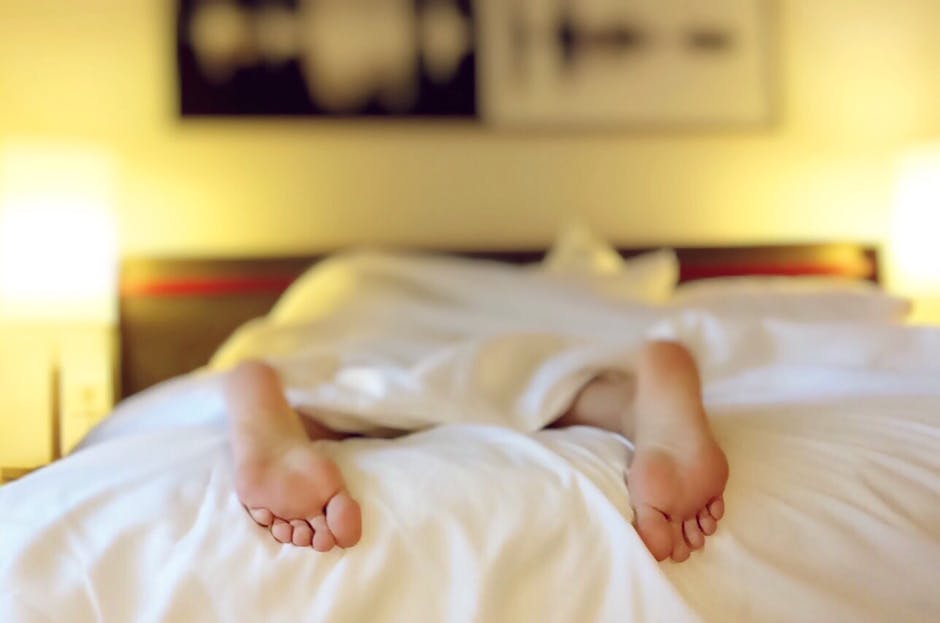Oversleeping can disrupt your daily routine, impact productivity, and lead to various health issues. Achieving a balance between getting enough rest and avoiding oversleeping is essential for overall well-being. This article will guide you through understanding your sleep needs, establishing a sleep schedule, creating a sleep-inducing environment, implementing relaxation techniques, adopting lifestyle changes, using sleep aids and technology, and addressing sleep disorders to help you manage your sleep patterns and wake up feeling refreshed.
Understanding Your Sleep Needs
In order to avoid oversleeping and maintain a healthy lifestyle, it’s essential to understand your body’s natural sleep rhythms, the amount of sleep required for various age groups, and factors affecting sleep quality. This guide will provide valuable insight and practical tips to help you achieve the right balance of sleep.1. Learn about circadian rhythms: Our bodies follow a 24-hour cycle known as the circadian rhythm, which regulates when we feel awake and when we feel sleepy. It’s essential to keep this rhythm in sync for optimal sleep.2. Establish a consistent sleep schedule: Going to bed and waking up at consistent times each day can help synchronize your body’s internal clock, making it easier to fall asleep and wake up.3. Pay attention to your body’s signals: Listen to your body and take note of when you start feeling tired in the evening, and when you naturally wake up in the morning without an alarm. This can help you determine the best sleep schedule for your body.1. Infants (4-11 months): 12-15 hours (including naps)2. Toddlers (1-2 years): 11-14 hours (including naps)3. Preschoolers (3-5 years): 10-13 hours (including naps)4. School-age children (6-13 years): 9-11 hours5. Teenagers (14-17 years): 8-10 hours6. Young adults (18-25 years): 7-9 hours7. Adults (26-64 years): 7-9 hours8. Older adults (65+ years): 7-8 hours1. Environment:a. Keep your bedroom dark, cool, and quiet.b. Invest in a comfortable mattress and pillows.c. Remove or minimize electronic devices and distractions.2. Routine:a. Establish a consistent pre-sleep routine to signal your body it’s time for bed.b. Avoid caffeine, nicotine, and alcohol close to bedtime.c. Incorporate relaxation techniques like deep breathing, meditation, or gentle stretching into your bedtime routine.3. Daily habits:a. Get regular exercise, preferably earlier in the day and not too close to bedtime.b. Spend time outdoors during daylight hours to help regulate your circadian rhythm.c. Avoid long naps, especially in the late afternoon or evening.4. Stress and emotional wellbeing:a. Address any sources of stress in your life that may be affecting your sleep.b. Seek professional help if you suffer from anxiety or depression, as these can disrupt sleep.Understanding your body’s natural sleep rhythms, the amount of sleep needed for your age group, and factors affecting sleep quality can help you make informed decisions about your sleep habits. Implement these strategies and stay consistent in your efforts to achieve a balanced and healthy sleep schedule, ultimately helping you avoid oversleeping and feel more refreshed each day.

Establishing a Sleep Schedule
The Importance of a Consistent Sleep Routine
- Better sleep quality: A consistent sleep schedule ensures your body and mind have adequate rest, which leads to better overall sleep quality.
- Improved mental health: Regular sleep patterns can help reduce stress, anxiety, and depression.
- Enhanced focus and productivity: A well-rested individual is likely to be more focused, alert, and productive throughout the day.
- Stronger immune system: Adequate sleep is essential for maintaining good health and helping the immune system function optimally.
- Balanced hormones: Consistent sleep patterns help regulate hormone levels and maintain a healthy weight.
Creating an Ideal Sleep Schedule
- Determine your sleep needs: The optimal amount of sleep varies from person to person, but most adults require between 7-9 hours of sleep each night. Consider your personal sleep needs and daily responsibilities when setting your bedtime and wake-up time.
- Choose a consistent bedtime: Going to bed at the same time every night helps train your body to follow a regular sleep pattern.
- Create a relaxing bedtime routine: Engage in calming, soothing activities before bedtime to signal to your brain that it’s time to wind down (e.g., reading, taking a warm bath, or practicing relaxation techniques).
- Turn off electronic devices: Disconnect from screens at least an hour before bedtime to reduce exposure to blue light, which can hinder sleep.
- Maintain a sleep-friendly environment: Keep your bedroom cool, dark, and quiet to promote optimal sleep conditions.
Adjusting Sleep Patterns Over Time
- Adapt gradually: If you’re making significant changes to your sleep schedule, do so in small increments (e.g., shift bedtime/wake-up time by 15-30 minutes) to allow your body time to adjust.
- Stay consistent on weekends: Try to maintain your sleep schedule even on weekends or days off to promote consistency and prevent “social jetlag.”
- Adjust for time zone changes: When traveling across time zones, begin adjusting your sleep schedule by a few hours in the days leading up to your trip to ease the transition.
- Use natural light exposure: Exposure to natural light in the morning and throughout the day can help regulate your natural sleep-wake cycle.
- Consult medical advice: If you’re struggling with insomnia or sleep disturbances, consult a healthcare professional or a sleep specialist for further guidance.

Creating a Sleep-Inducing Environment
Title: Creating a Sleep-Inducing Environment to Avoid OversleepingA relaxing sleep environment plays a crucial role in getting quality sleep and avoiding oversleeping. The right room temperature, lighting, and noise control techniques can help you fall asleep faster, ensure a good night’s sleep, and wake up feeling refreshed. This guide will teach you how to create a sleep-inducing environment to prevent oversleeping.Understanding the Benefits of a Relaxing Sleep Environment1. Improved sleep quality: A comfortable sleep environment allows your body to get the necessary deep sleep and REM sleep, both vital for maintaining overall health.
2. Reduced stress and anxiety: Calm surroundings can lower stress levels, helping you to feel more relaxed and ultimately leading to better sleep.
3. Increased energy levels: When you get quality sleep, your energy levels increase throughout the day, leading to improved productivity and well-being.Room Temperature1. Optimal temperature: The ideal room temperature for sleep is between 60 and 67 degrees Fahrenheit (16-19 degrees Celsius). Experiment within this range to find the temperature that feels most comfortable.
2. Use a programmable thermostat: This can help regulate the temperature in your bedroom throughout the night, ensuring that it remains consistent.
3. Opt for breathable sheets: Choose lightweight, breathable sheets made from fabrics like cotton or linen. These materials naturally regulate temperature and wick away moisture to keep you comfortable.Lighting1. Dim the lights before bedtime: Reduce the brightness of the lights in your home an hour before bedtime to signal to your body that it’s time to wind down and prepare for sleep.
2. Use blackout curtains or shades: These can help eliminate any natural or artificial light that might disturb your sleep.
3. Opt for warm-toned, low-wattage bulbs: Replace bright, cool-toned bulbs in your bedroom with softer, warm-toned ones to create a more relaxing atmosphere.
4. Limit exposure to blue light: Turn off electronic devices, including smartphones, tablets, and televisions, at least an hour before bedtime, as blue light can interfere with your body’s natural sleep-wake cycle.Noise Control Techniques1. Use a white noise machine: White noise machines produce calming sounds that can help drown out any disruptive noises and soothe you to sleep.
2. Try earplugs: Earplugs can be an effective solution for blocking out noise while you sleep.
3. Play soft, calming music: Gentle instrumental music or nature sounds can help create a relaxing atmosphere and promote sleep.
4. Improve insulation: Sealing gaps around windows and doors and using heavy curtains or rugs can help decrease noise levels in your bedroom.Creating a sleep-inducing environment is essential to prevent oversleeping and ensure you get the rest your body needs. By maintaining a comfortable room temperature, dimming lights, and using noise control techniques, you can make your bedroom a sanctuary for restorative sleep. Adopting these practices will help improve your overall health and well-being, while ensuring that you wake up refreshed each day.

Implementing Relaxation Techniques
Oversleeping can make you feel groggy and unproductive throughout the day. By incorporating relaxation techniques before bedtime, you can improve your sleep quality and make it easier to wake up when you need to. This guide will teach you about deep breathing, progressive muscle relaxation, and mindfulness practices that can help you ease into sleep and avoid oversleeping.4-7-8 Breathing: This method helps to calm the nervous system and promote relaxation. Sit or lie down in a comfortable position. Close your eyes and inhale through your nose for a count of 4. Hold your breath for a count of 7. Exhale through your mouth for a count of 8. Repeat this cycle 3-4 times before your normal bedtime routine.Diaphragmatic Breathing: Also known as “belly breathing,” this technique helps you focus on using your diaphragm rather than your chest when breathing. Lie down on your back with your knees bent and place a pillow under your head. Place one hand on your chest and the other on your stomach. Inhale slowly through your nose, feeling your stomach rise as your diaphragm expands. Exhale slowly through your mouth, allowing your stomach to fall. Practice this technique for 5-10 minutes before bedtime.Progressive Muscle Relaxation (PMR): PMR is a technique where you intentionally tense and relax specific muscle groups in sequence to release tension and promote relaxation. Lie down in a comfortable position. Starting with your toes, tense the muscles as much as possible and hold for 5 seconds. Release the tension and relax the muscles for 10 seconds. Move up to the next muscle group (ankles, calves, thighs, etc.), repeating the process until you’ve worked through your entire body. End with deep abdominal breaths to further relax your body.Body Scan Meditation: This practice helps you focus on sensations in your body and release tension. Lie down in a comfortable position. Start at your toes and work your way up your body, noticing any sensations, tension, or discomfort. As you focus on each body part, consciously release any tension or discomfort. Continue this process until you’ve scanned your entire body.Guided Imagery: This practice involves visualizing peaceful and calming images to help relax your mind. Close your eyes and take a few deep breaths. Imagine a peaceful scene (e.g., a beach, mountain, or meadow) and engage all your senses (see, hear, smell, taste, and touch) in this mental image. Stay in this peaceful scene for 5-10 minutes, taking deep, slow breaths.Incorporate these relaxation techniques into a consistent bedtime routine. Set a specific time for going to bed and sticking to it. Turn off electronic devices at least 30 minutes before bedtime. Create a sleep-friendly environment by making your bedroom quiet, dark, and comfortable.Keep a sleep diary to track your relaxation techniques and sleep habits. Take note of any improvements or challenges you face. Adjust your relaxation techniques and routine as needed to optimize your sleep quality.

Adopting Lifestyle Changes
Adopting Lifestyle Changes to Avoid Oversleeping
Oversleeping can lead to a lethargic and unproductive day. To avoid this, adopting lifestyle changes is vital. These changes include reducing caffeine and alcohol consumption, engaging in regular exercise, and establishing a pre-sleep routine to improve overall sleep quality.
Step 1: Reduce Caffeine Intake
- Gradually decrease your caffeine consumption to prevent withdrawal symptoms.
- Avoid consuming caffeine after 2 p.m. as it has a half-life of about 5-6 hours.
- Opt for alternatives like herbal tea, decaffeinated coffee, or simply drink water.
- Be aware of hidden caffeine sources like chocolate, soda, and certain medications.
Step 2: Limit Alcohol Consumption
- Reduce the amount of alcohol consumed, especially during the evening.
- Avoid consuming alcohol within 3 hours before bedtime, as it can interfere with your sleep cycle.
- Consider substituting alcohol with non-alcoholic beverages like mocktails or sparkling water.
- Set a goal to have a specific number of alcohol-free days per week.
Step 3: Engage in Regular Exercise
- Aim for at least 30 minutes of moderate exercise per day, such as brisk walking, swimming, or yoga.
- Schedule your exercise sessions in the morning or early afternoon, as exercising too close to bedtime may disrupt sleep.
- Incorporate strength training and stretching exercises to help improve sleep quality.
- Stay consistent with your exercise routine to experience long-term sleep benefits.
Step 4: Establish a Pre-Sleep Routine
- Create a consistent bedtime and wake-up time, even on weekends.
- Turn off electronic devices 30 minutes to an hour before bedtime to reduce exposure to blue light, which can interfere with sleep.
- Make your sleep environment as comfortable as possible, including a supportive mattress, comfortable pillows, and temperature regulation.
- Engage in calming activities before bed, such as reading a book, taking a warm bath, or practicing meditation.
Step 5: Monitor Your Progress
- Keep a sleep diary to track your changes in sleep patterns and behaviors.
- Assess your energy levels, mood, and productivity throughout the day to gauge the effectiveness of your lifestyle changes.
- Make adjustments as needed, and continue to implement healthy practices that support your sleep quality.
- Seek professional help if oversleeping continues to be a persistent issue.
Conclusion
By adopting lifestyle changes such as reducing caffeine and alcohol consumption, engaging in regular exercise, and establishing a pre-sleep routine, you can improve your sleep quality and successfully avoid oversleeping. Consistency is key, and with patience, you’ll experience the benefits of a healthier and more energized life.

Using Sleep Aids and Technology
Oversleeping can impact your productivity and overall well-being. In order to consistently wake up on time and feel refreshed, you may consider using natural sleep aids, sleep tracking devices, and alarm clock apps. This guide will help you evaluate and use these tools effectively to avoid oversleeping.1. Evaluate Natural Sleep Aids:
a. Melatonin: Melatonin is a hormone that helps regulate sleep-wake cycles. Taking a melatonin supplement about an hour before bedtime can help signal your body that it’s time to sleep.
b. Valerian Root: Valerian root is an herbal supplement that may help improve sleep quality and reduce the time it takes to fall asleep.
c. Lavender: The scent of lavender has been shown to promote relaxation and improve sleep quality. Use lavender essential oil in a diffuser or spray it on your pillow before bedtime.
d. Chamomile: Drinking chamomile tea before bed can help relax your body and prepare you for sleep.
e. Consult a doctor before using any natural sleep aids, especially if you’re pregnant, nursing, or taking other medications.2. Sleep Tracking Devices:
a. Wearable sleep trackers: Devices such as the Fitbit or Garmin can monitor your sleep cycles and provide insights into your sleep patterns. Use this data to adjust your bedtime routine and improve your sleep quality.
b. Non-wearable sleep monitors: Devices like the Beddit or SleepScore Max can be placed on your mattress or bedside table to track your sleep without needing to wear anything on your wrist.
c. Evaluate the accuracy of the data provided by these devices and consider if the insights have been helpful in improving your sleep quality and waking up on time.3. Alarm Clock Apps:
a. Smart Alarm clock apps: Apps like Sleep Cycle or Sleep As Android monitor your sleep patterns and wake you up during a lighter phase of sleep, making it easier to wake up feeling refreshed and avoid oversleeping.
b. Customize alarm sounds: Choose an alarm tone that is pleasant yet effective at waking you up. Gradually increasing volume and soothing melodies can be less jarring and help you wake up more gently.
c. Multiple alarms: Set multiple alarms at different times if you’re a heavy sleeper or prone to turning off your alarm and going back to sleep.
d. No snooze: Disable the snooze function. Instead, place your alarm clock or phone across the room, forcing you to get out of bed to turn it off. This makes it harder to go back to sleep.By effectively using natural sleep aids, sleep tracking devices, and alarm clock apps, you can improve your sleep quality and wake up on time consistently. Always consult a medical professional before using sleep aids and commit to a consistent sleep routine for the best results.

Addressing Sleep Disorders
Oversleeping can impede daily productivity and negatively affect mental and physical health. Understanding and managing your sleep disorders is the key to waking up feeling refreshed and maintaining a balanced lifestyle. In this guide, we will discuss common sleep disorders such as insomnia, sleep apnea, and circadian rhythm disorders. We will also provide tips on how to effectively manage these sleep disorders to avoid oversleeping.Insomnia refers to the difficulty in falling asleep or staying asleep throughout the night. This disorder results in poor quality sleep, which might lead to oversleeping to compensate for the lack of rest. To manage insomnia, consider the following steps:a. Establish a consistent sleep schedule by going to bed and waking up at the same time every day, even on weekends.b. Create a relaxing bedtime routine, such as taking a warm bath, reading a book, or practicing meditation.c. Maintain a sleep-conducive environment by keeping your bedroom cool, quiet, and dark.d. Limit exposure to screens (TV, computer, phone) at least one hour before bedtime.e. Exercise regularly, but avoid rigorous activities close to bedtime.If your insomnia persists, consult a healthcare professional for further evaluation and treatment.Sleep apnea is a disorder characterized by pauses in breathing or shallow breaths during sleep. This condition often leads to frequent awakenings, resulting in poor sleep quality and the need for excessive sleep. To manage sleep apnea:a. Speak with a healthcare professional for a proper diagnosis and treatment plan.b. Change your sleep position by elevating your head or sleeping on your side to open your airway.c. Avoid alcohol, sedatives, and muscle relaxants, as they may worsen sleep apnea.d. Maintain a healthy weight, as obesity can be a contributing factor to sleep apnea.e. Practice good sleep hygiene by creating a consistent sleep schedule and bedtime routine.Circadian rhythm disorders occur when your internal clock, which regulates your sleep-wake cycle, is out of sync with external factors, such as daylight hours. This misalignment can lead to sleep disruption and oversleeping. To manage circadian rhythm disorders:a. Prioritize exposure to natural light during the day, especially in the morning, to help regulate your circadian rhythm.b. Avoid exposure to artificial light, especially blue light from screens, in the evening.c. Try gradually adjusting your sleep schedule if you are experiencing jet lag or shift-work-related sleep disruptions.d. Speak with your healthcare professional about the possibility of using light therapy or melatonin supplements.e. Maintain a regular sleep schedule and calm bedtime routine to help train your body for sleep.Managing common sleep disorders is crucial to achieving better sleep and preventing oversleeping. By taking steps to treat insomnia, sleep apnea, and circadian rhythm disorders, you can work towards a healthier sleep routine and improve your overall well-being. If you continue to struggle with sleep, consult your healthcare professional for additional guidance and support.

By understanding your sleep needs, creating a consistent sleep schedule, optimizing your sleep environment, practicing relaxation techniques, making lifestyle adjustments, and using sleep aids and technology effectively, you can prevent oversleeping and wake up on time. Don’t forget the importance of addressing any underlying sleep disorders, as these may significantly impact your sleep quality and ability to wake up refreshed. Remember, a well-balanced sleep routine leads to better physical, emotional, and mental health.

Recent Comments